Nothing completes your home kitchen quite as a pantry does. When installing a pantry, it needs to be wide enough to fit everything while leaving you enough room to reach around inside. So, how wide should pantry shelves be, exactly? In this post, we'll share our research on this question with you.
A standard pantry has shelves up to 2 feet wide, more or less. The size of your kitchen plays a big part in how wide your shelves can get, not to mention the height and depth of your pantry.
The width of pantry shelves usually varies. Read on as we go over different types of pantries and their standard measurements. Pantries can range in size, from small corners to walk-in pantries. This means you need to get the proportions of each measurement just right.
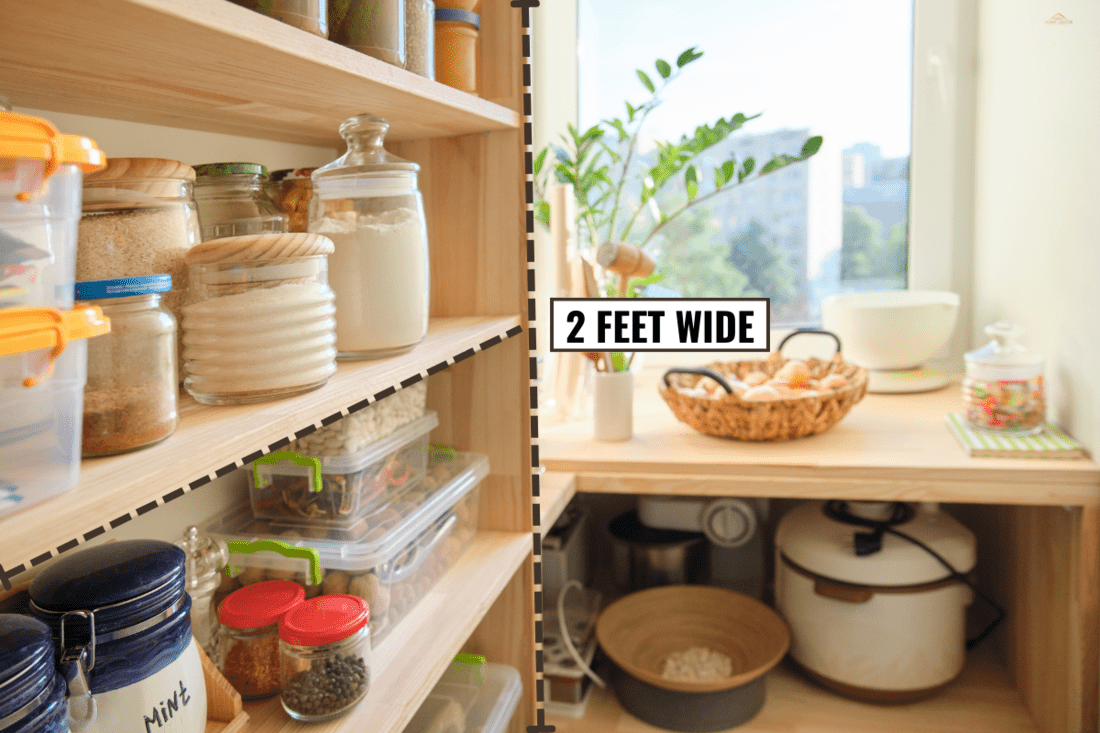
What Is The Standard Pantry Width?
Pantry shelves are dependent on the size of the pantry. Typically, pantries range from 2 to 5 feet wide. You can even have wider shelves if you have the space for them.
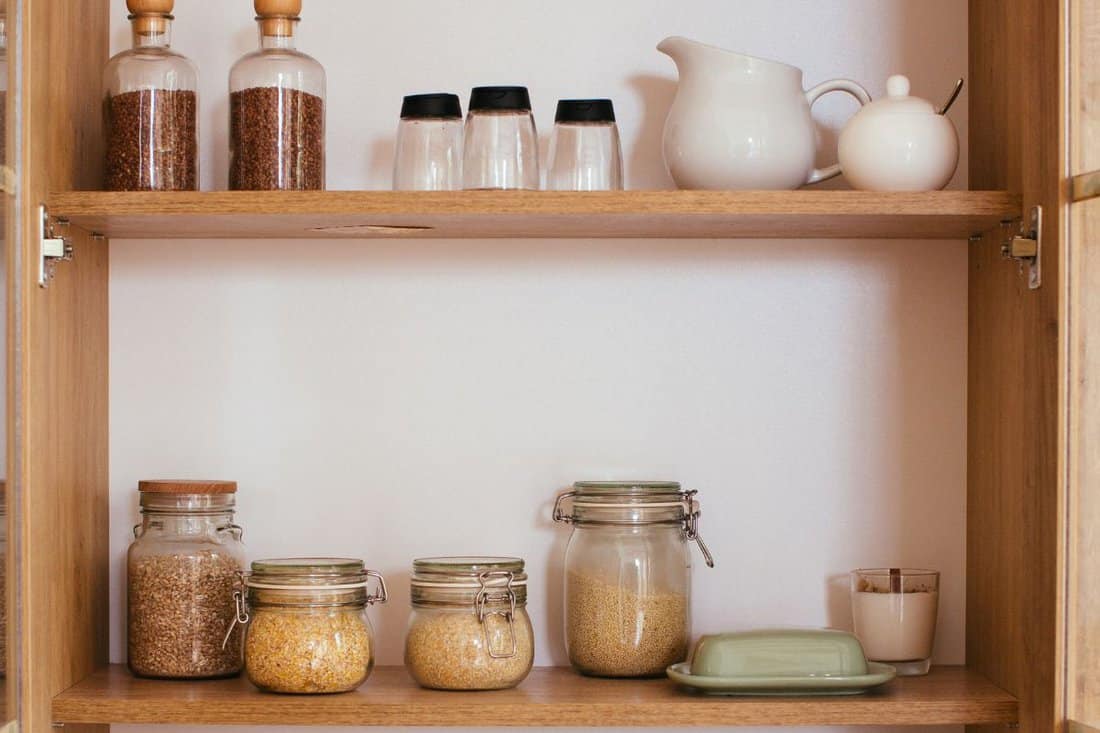
We may include affiliate links and curated AI content to highlight top design styles.
Consider what you will be putting in your pantry. You can take liberties with the height of each shelf. Cereal boxes, jars, bottles, and containers come in different heights. If you can, focus on this aspect to ensure your food fits on the shelves perfectly.
What Is The Best Distance Between Pantry Shelves
Shelves are typically 8 to 12 inches apart from each other, but this range can be bigger for pantries. Here is a guide that you can refer to when figuring out the spacing or shelf height between your pantry shelves:
- For canned goods: 7 inches (the average can is 4 to 5 inches tall).
- For cereal boxes: 14 to 16 inches (most cereal boxes are 12 inches tall).
- Bigger items and containers: 18 to 20 inches.
- Bottom shelf clearance: 20 to 24 inches clearance.
The clearance underneath your pantry is perfect for smaller baskets, sacks, or anything too heavy to place on the shelves.
You can get pantries with adjustable shelf heights for your convenience. In this case, every shelf must be the same width so that they can fit at any level when you move them around. You can also build adjustable pantry shelves if you like to do DIY projects.
The overall pantry height should not be too high or too low if you can help it. The usual range is 5 to 8 feet tall. Pantries on the higher side might need stepping stools handy to reach the upper shelves.
What Is The Best Depth For Pantry Shelves?
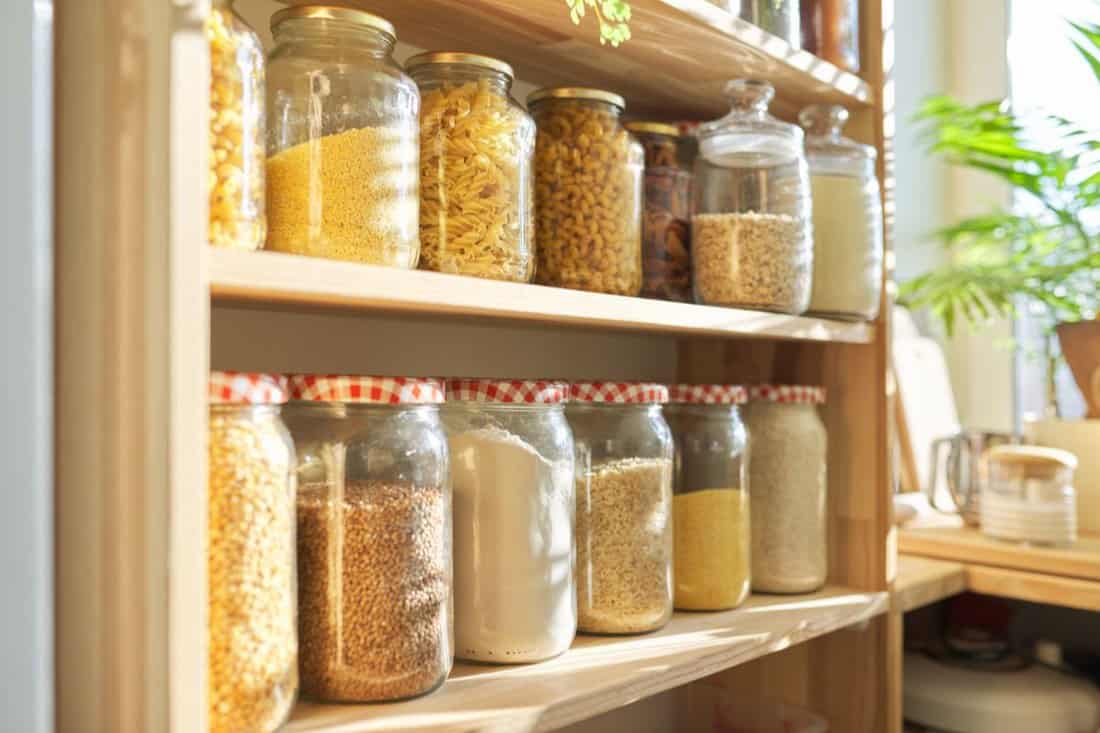
Pantry shelves should have a depth of 16 to 20 inches at most. However, 12 inches may be enough. Your pantry shelves should not be too deep since it will be a hassle to take things out.
Remember that people tend to use the things they see most often. Having food tucked deep within in your pantry will make it hard to remember that it is there. You may even end up overstocking if you do not regularly move things to the front or even forget that there's food on the shelf, allowing it to go bad or expire.
If you do not have as much space, you could get away with a pantry that is only 6 inches deep. This should be enough for at least one row of items, though there is significantly less space for stocking up.
Walk-In Pantry Dimensions
Walk-in pantries are versatile in how they can be constructed and laid out. You will want to maximize the space inside as much as possible, even if you want a lot of it. A good set of measurements for a walk-in closet would be 5 feet by 6 feet, with 3 feet of walking space.
Your pantry can follow the standard shelf width of 2 feet. Feel free to make the shelves wider if you want to extend the length of your walk-in pantry.
How To Maximize Shelf Space In Pantry
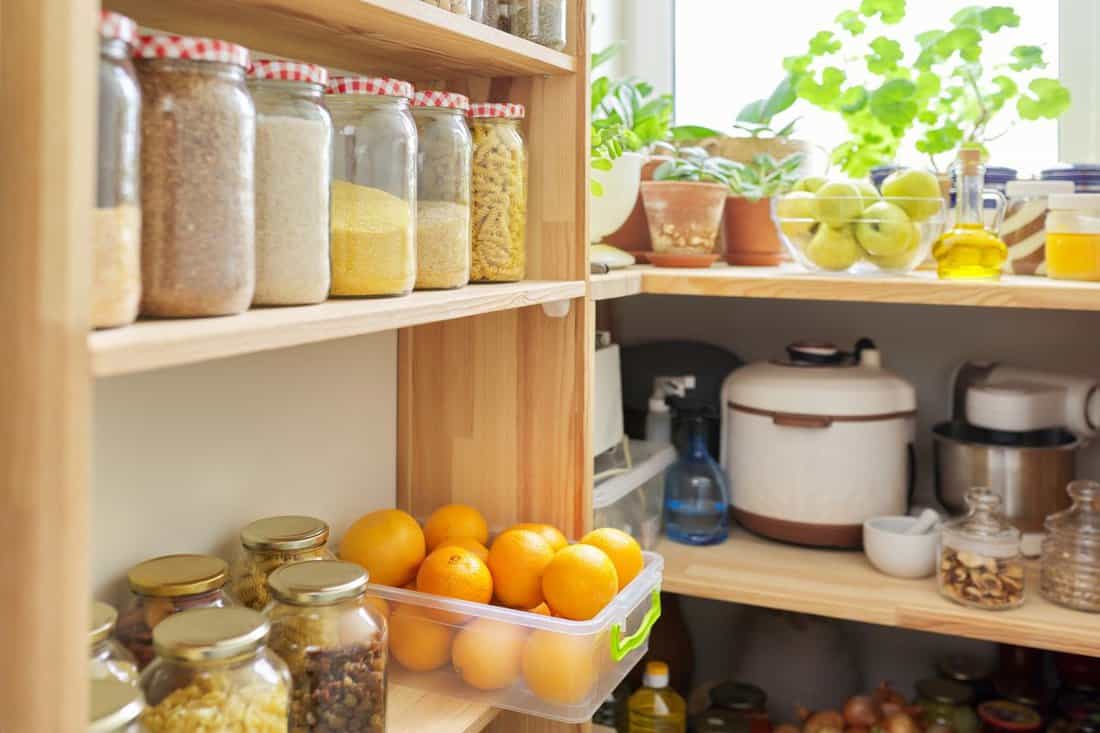
You might want some tips on the best use of your space. The right strategy can turn your messy pantry into an organized and efficient system.
You do not want to waste time looking for things in the pantry, so place contents in easy-to-reach areas. Give each item a specific spot in your pantry so that its location eventually becomes muscle memory for you.
Store things you normally use in the middle shelves (around the waist to chest level) to make them quick to grab. Label repackaged items, or even add labels to the different areas in your pantry.
Have storage solutions in your pantry, like baskets, containers, or wire racks. These can help you pile things on top of each other that would otherwise be difficult. You want to be using up as much space as you can while still making your pantry accessible.
You can keep almost any kitchen necessity in your pantry, aside from the ones that must be refrigerated. No matter the size of your space, you can find a way to keep more than just food items inside. Store things like paper towels, cooking tools, knives, and more.
While you can keep non-food items in your pantry, there are things you must never keep inside. Do not store chemicals like bleach or cleaning products inside your pantry, since this can be toxic if there are leaks.
Click here to see airtight food containers on Amazon.
Pantry Shelf Spacing Ideas
With all of the ways you can organize your pantry, it can feel a little overwhelming. Here are some pantry ideas for you to get inspiration from.
Pantry Storage Solutions
This pantry uses storage solutions like baskets, jars, and lidded containers to keep everything together. The containers even have labels to help out with storage a bit more. Notice how this leaves a lot of blank space, with little mess from the loose packages.
Small Pantry
Here is a smaller pantry that still has a lot of storage going on. Notice how the jars are stacked on a staircase-like holder on the middle shelf on the right. The jars on the shelf above also have some stacking going on.
Holders for setups like these are great because you do not have to stack the jars on top of one another. While stacking jars directly can certainly save a lot of space, it can be a hassle to take things out of your pantry.
Walk-in Pantry
In this last photo, you can see one portion of a walk-in pantry. The shelves are wide and stretch out beyond 2 feet into the walls. The mason jars and containers are more tightly packed, and some are even stacked. Baskets are used to store loose packages underneath, with space for liquor.
Notice how the pantry has moveable steps installed. This is handy for reaching the higher shelves where some containers are placed near the ceiling.
What Makes A Good Pantry?
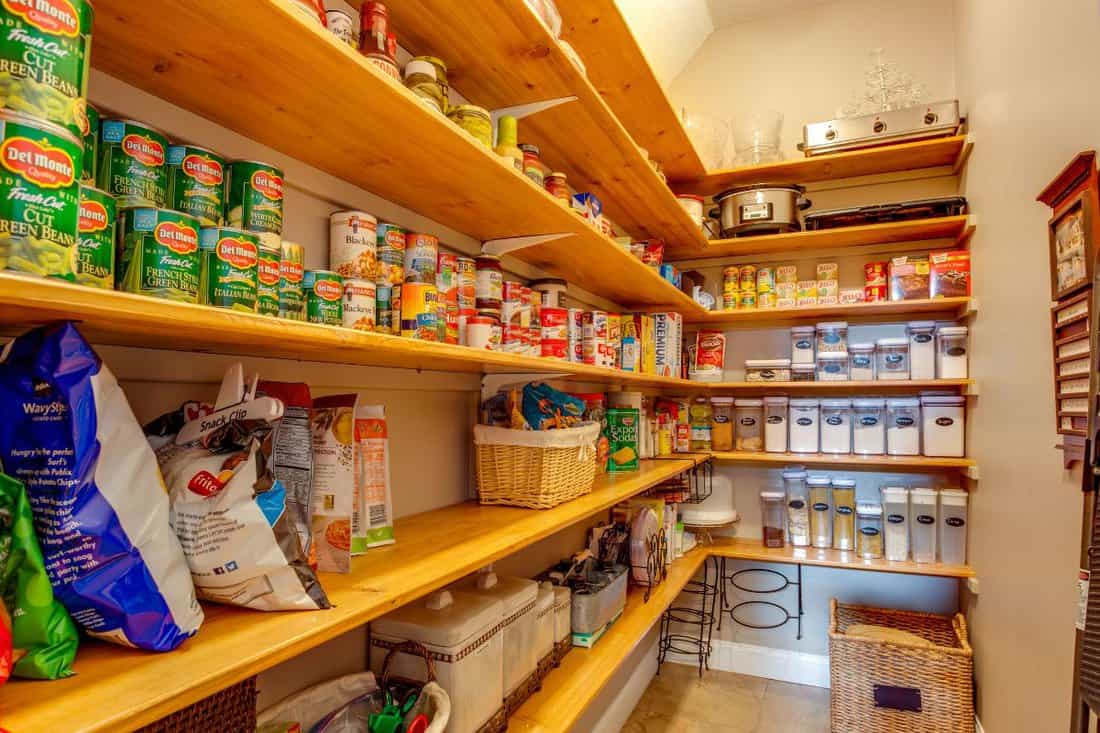
A good pantry is well-stocked, organized, and clean. Keep pests and dirt out of the pantry at all times. While your pantry does not have to look immaculate, maintaining yours regularly is necessary.
How To Safely Store Things In Your Pantry
One of the best ways to keep track of things in your pantry is by keeping an inventory. Include the date each item was first stocked in, as well as the expiration date. This way, you know which items need replenishing or replacing once you run out.
When repackaging food, always keep them in airtight containers. Also, make sure that the temperature in the pantry is not too extreme.
Apart from the non-food items mentioned, here are a few food items that you should not store in the pantry:
- Mustard, infused olive oil, maple syrup
- Opened canned food
- Nuts, nut butter
- Unsealed cured meats
- Bread
- Chocolate, chocolate chip cookies
These food items are at high risk of developing mold or going stale in the pantry. Avoid health risks by storing them in your fridge instead. The pantry can also get quite warm, so it will melt things like chocolate if you store it inside.
Wrapping Things Up
Pantry shelves should be around 2 feet wide as a standard, though they can get much wider than that. So long as the depth and height of your pantry are proportional to the width, it should serve you just fine. You can use adjustable shelves and storage solutions in your pantry to maximize the space.
Did you find this post helpful? If you did, check out our other articles before you go:


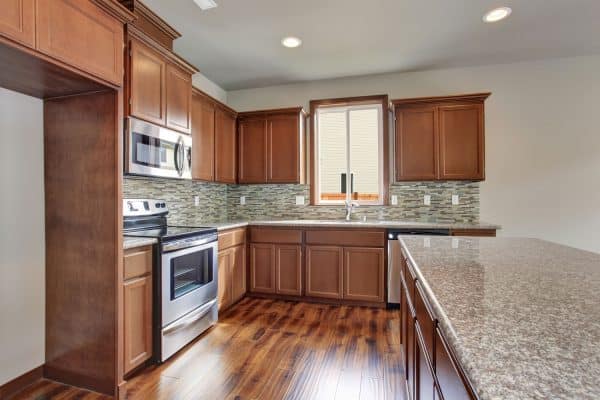
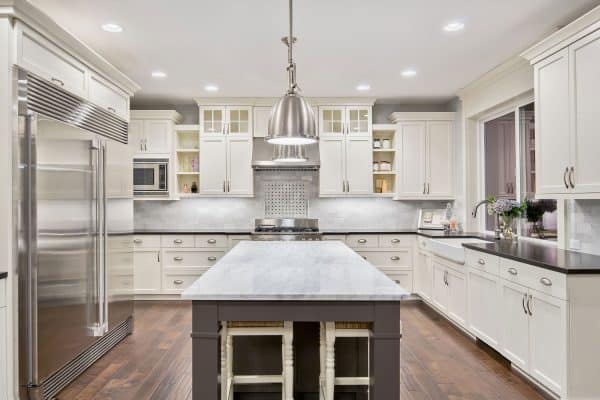
![Beautiful Kitchen in New Luxury Home with Refrigerator, Oven, Hardwood Floors, Kitchen Island, and Pendant Lights, Is Granite Cheaper Than Quartz? [Which Is Better?]](https://homedecorbliss.com/wp-content/uploads/2022/12/Beautiful-Kitchen-in-New-Luxury-Home-with-Refrigerator-Oven-Hardwood-Floors-Kitchen-Island-and-Pendant-Lights-600x400.jpg)